Arugula - a type of salad, which is becoming more popular among gardeners. Grown in open ground, greenhouse, on the windowsill. Arugula grown at home, planting and caring for it is not difficult, it allows you to get vitamin greens all year round.
Material Content:
Arugula: the nuances of growing
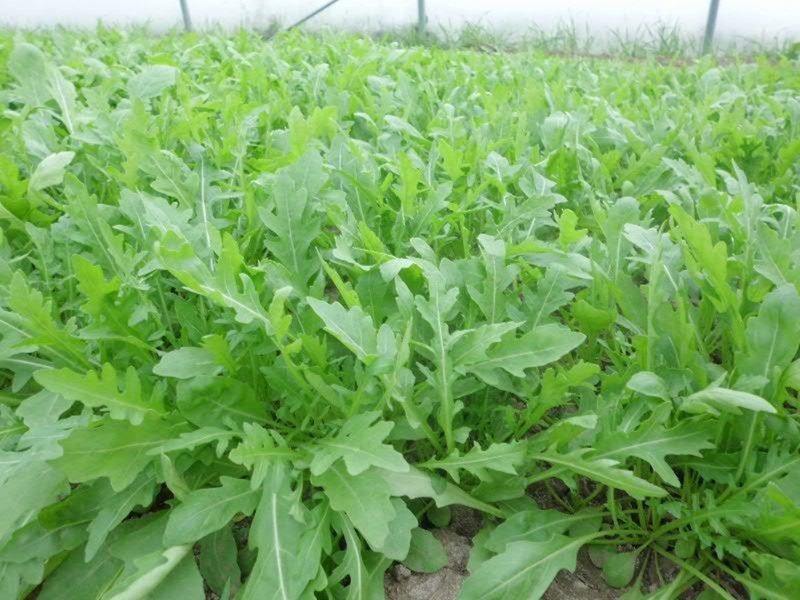
For arugula choose a sunny place, but at noon it must be shaded from direct sunlight. The plant needs watering, which is carried out several times a week, preventing water stagnation. Soil for growing requires loose and light, preferably neutral or slightly acidic. The beds are prepared in the fall, seasoned with humus or compost, if necessary add lime or dolomite powder.
Outdoor landing
Arugula has a short growing season, so it can be planted on beds several times during the summer. The first planting of seeds in the ground is carried out in April. In the future, they land after two weeks. The plant reaches the highest taste quality and the number of useful elements in 25-50 days, depending on the variety.
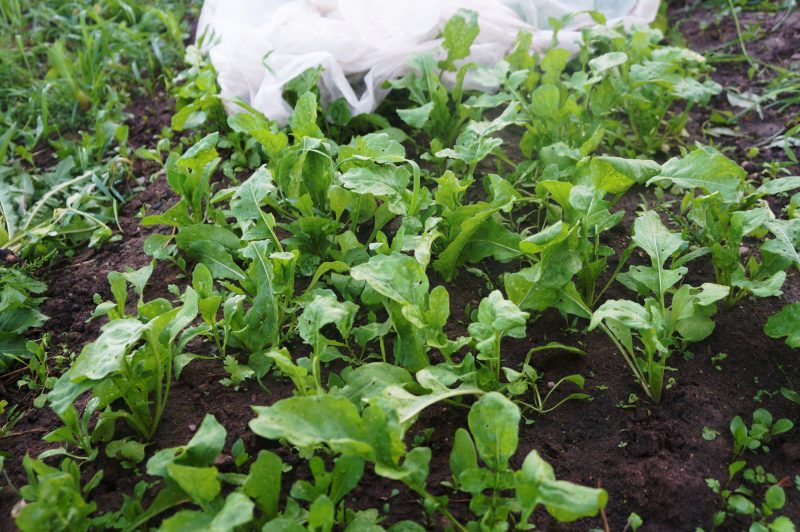
We loosen the soil on the prepared ridges, then we begin to cut grooves with a depth of 1.5 cm, we make a distance of 30 cm between them. Water the furrows, shed well with a solution of phytosporin or potassium permanganate to remove diseases in the soil. We spread the seeds through 5 cm, sprinkle with a thin layer of earth. When sowing in April, we cover with a film. For the appearance of seedlings, 7-140C is enough. Seeds germinate a week after sowing.
An important point for obtaining a good crop of arugula is the choice of predecessors when planting it.It is good to plant on the ridge where a year earlier pumpkins, tomatoes, legumes, carrots and potatoes were grown. You can not use areas where representatives of cruciferous plants grew - cabbage, radish, horseradish and others.
Do you need seedlings for growing arugula
Arugula can be perfectly grown in open field seeds. On the windowsill, it is planted for year-round production of vitamin greens. If you want to get an early harvest, you can grow seedlings.
Start sowing seeds in March. Disposable or peat cups are filled with prepared soil. In each, you can plant 2-3 seeds. Soaking them is not necessary, the arugula has good germination. Seedlings do not like picking, so they immediately plant it in separate containers.

Glasses are placed on a light windowsill. Lighting should be diffuse, but adequate. With a lack of light, the leaves will be pale and the shoots will be very elongated. The plant loves good watering, watering seedlings every other day, make sure that the water does not stagnate, is completely absorbed into the soil.
Transplanting seedlings into the soil can not injure its root system. When using peat pots, they are buried in the ground along with the plant. If the seedlings are in a plastic cup, they cut it, a plant with a lump of earth is taken out and planted in the ground.
Initially, seedlings need to be covered until warm weather sets in. It can be planted in the greenhouse. Care is carried out, as usual. Water and loosen, in hot weather, a greenhouse is aired.
Arugula Care
The plant receives good growth at an ambient temperature of 18 to 24 ° C. With strong heat, the leaves become stiff, at low temperatures it grows poorly.
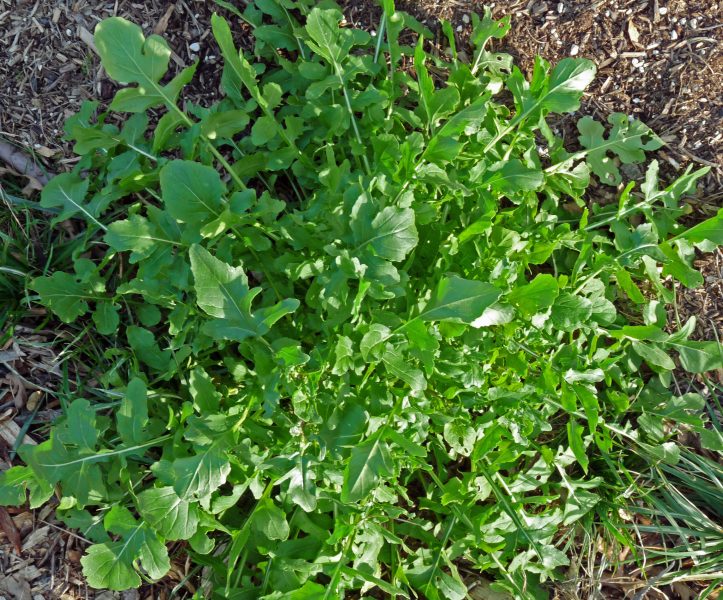
This is not to say that arugula is an unpretentious plant. The best solution in this case is a well-fertilized soil before planting the plant. The best will be the organic elements in the soil. Mineral fertilizers, especially nitrogen fertilizers, lead to the accumulation of nitrates in the green of arugula.
Loosening the soil is necessary for the growth of green crops. To loosen less and interfere with the growth of weeds, it is good to use soil mulching. For this, dry grass, peat, sawdust are used. Thickened plantings are thinned out.
The importance of watering
Watering the arugula should be regular, in hot, dry weather, watered daily in the morning or in the evening, the rest of the time - every other day. Dry soil is not allowed for the plant. Leaves become coarse, unsuitable for eating, bitterness appears in them.
When to collect arugula
They start to cut the bushes when it takes about 25 days after the emergence of seedlings. You can remove not the whole plant, but individual leaves when they reach a length of 10-12 cm. To make the plant branch better, pinch the tops of the shoots from it. When to collect arugula depends on the variety.
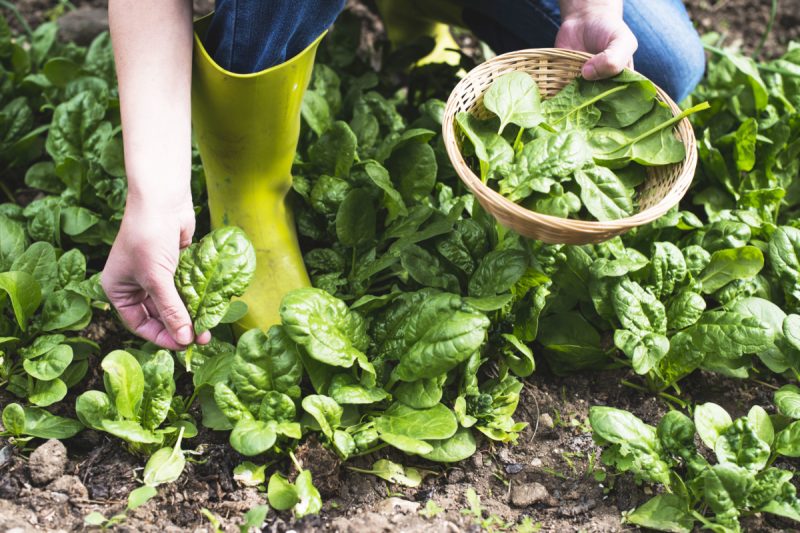
Greens must be harvested before the flowering of the crop begins, otherwise a delicious delicate product will not work. To obtain seeds, several plants are left in the garden. Arugula greens are not stored for a long time, even in the refrigerator it will wither for a few days. Ripe arugula seeds are used in various seasonings.
Diseases, pests and methods of dealing with them
Diseases such as peronosporosis and fusariosis are possible. The first is characterized by brown spots on the leaves, with fusarium leaves turn yellow. Diseases can be avoided if the conditions for growing arugula are fulfilled - observe crop rotation during planting, do not plant a plant in the garden where crops with similar diseases grew in the past, and do not overmoisten or overdry the soil.
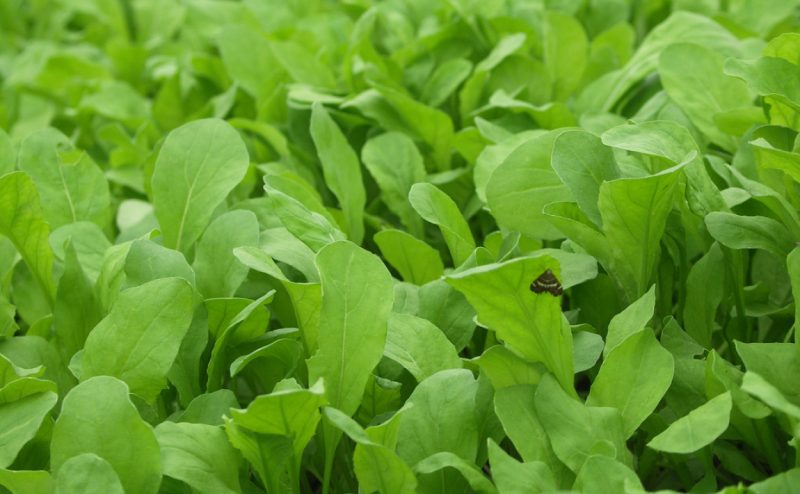
Of the pests, the cruciferous flea and cabbage moth damage the arugula. They leave holes on the leaves by which one can judge the appearance of pests. This plant cannot be treated with insecticides.
The main methods of pest control is the prevention of their occurrence. It is necessary to cultivate the soil before planting, remove weeds on time. When they appear, plants are treated with compounds that are not harmful to humans.You can sprinkle bushes with ash, tobacco dust, hot pepper, spray with infusion of wormwood. If there are a lot of insects, the plant is removed. The following crops are carried out in a new place, using covering material.
Popular types and varieties of arugula
By type of arugula is divided into annual and biennial. Each species is represented by certain varieties. By purchasing the seeds of a plant, it is already possible to determine by what name it belongs to which species.
Biennial varieties winter in the soil and in early spring they are pleased with fresh herbs. Annuals differ in maturity.
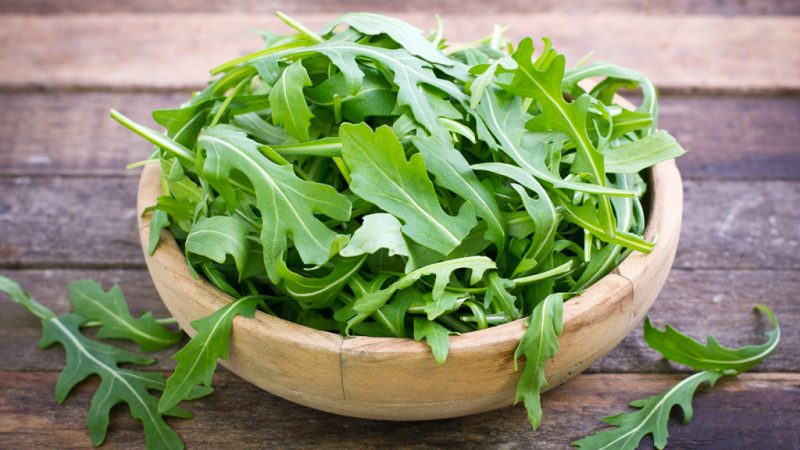
The early ones. They reach ripeness three weeks after emergence:
- Rocket;
- Olivetta;
- Victoria;
- Poker;
- Spartacus.
Medium varieties ripen two weeks later than the early ones:
- Cupid's Arrows;
- Curiosity;
- Solitaire.
Solitaire is a two-year-old species and tolerates winter well in open ground with little shelter.
A two-year-old is a two-leaved thin-leaved or wild Italian arugula. After cutting again gives a lush bush. Care for perennial varieties is the same as for sowing.
To get a good harvest of greenery, you need to consider its needs. Avoid dense sowing of seeds. When thinning, the roots of neighboring plants are disturbed, and the salad does not like this. For the same reason, seedlings are not dived. You can not sow in a flat container, the roots need dishes with a depth of at least 10 cm.
A good vitamin support in the winter is a bush of arugula in a pot on the windowsill. This does not require much time for care, but will please with its appearance. You only have to water the ground and pinch off the green leaves, adding them to salads and other dishes, getting a spicy nutty flavor in return.












